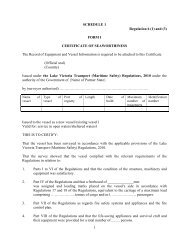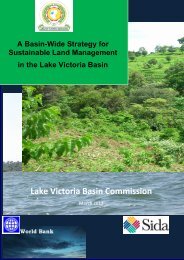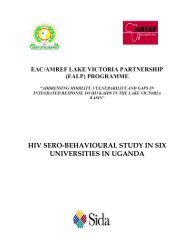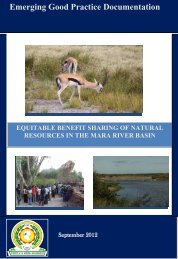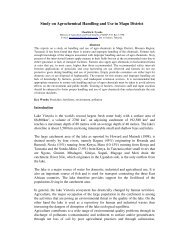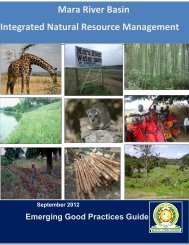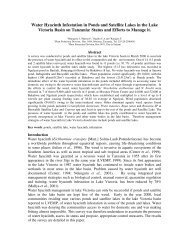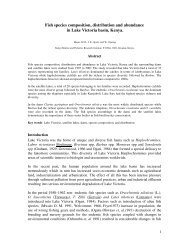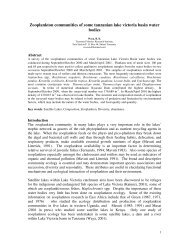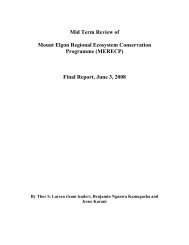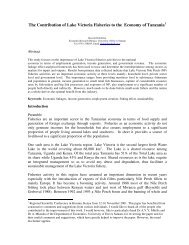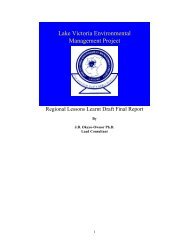Total Economic Value of Maasai Mau, Trans Mara and Eastern Mau ...
Total Economic Value of Maasai Mau, Trans Mara and Eastern Mau ...
Total Economic Value of Maasai Mau, Trans Mara and Eastern Mau ...
Create successful ePaper yourself
Turn your PDF publications into a flip-book with our unique Google optimized e-Paper software.
through burning or rotting when the trees die. Thus forests need to be managed inperpetuity to minimize release <strong>of</strong> the stored carbon into the atmosphere. Forest soilsform an important store <strong>of</strong> carbon <strong>and</strong> leaving them intact makes them an effectivecarbon sink, <strong>of</strong>fsetting significant amounts <strong>of</strong> carbon dioxide emissions annually.However, the capacity for carbon sequestration <strong>and</strong> storage in the <strong>Mau</strong> forest blocks hasbeen reduced by forest clearing <strong>and</strong> burning that have released large amounts <strong>of</strong> carbondioxide into the atmosphere. This negates the carbon sequestration balance sheet <strong>and</strong>the chances <strong>of</strong> benefiting from carbon trade facility. The current developments in thethree forest blocks reduces the amount <strong>of</strong> carbon stored in biomass by releasing morecarbon into the atmosphere mostly through forest clearing by burning. Thus the currentactivities lowers the capacity <strong>of</strong> the three forest blocks will to store carbon <strong>and</strong> hence thepotential carbon stock values.6.1.4 Water Provisioning for Human, Livestock <strong>and</strong> AgricultureThe excisions, encroachments <strong>and</strong> illegal logging have continued to destroy large areas<strong>of</strong> the forest blocks in the upper catchments <strong>of</strong> the <strong>Mara</strong> River Basin. For example,between 1986 <strong>and</strong> 2003 the closed canopy forest decreased by 23% whereas agriculturalactivities exp<strong>and</strong>ed by 55%. The conversion <strong>of</strong> the forests into agricultural l<strong>and</strong> <strong>and</strong>expansion <strong>of</strong> l<strong>and</strong> under intensive agriculture has increased soil erosion <strong>and</strong> reducedthe water flow regulation capacity <strong>of</strong> the forests <strong>and</strong> other vegetation. The currentthreats to water resources in the <strong>Mara</strong> River Basin are related to rapid populationgrowth <strong>and</strong> the associated intensification <strong>of</strong> small-scale agricultural activities in theheadwater catchments <strong>of</strong> the basin. These developments have significantly changed thequality <strong>and</strong> quantity <strong>of</strong> water flowing in the river. Current farming practices facilitatesoil erosion that carries along with it chemical fertilizers from farms. Current farmingpractices also diminish the rate <strong>of</strong> rainfall infiltration into soils <strong>and</strong> thus recharging <strong>of</strong>groundwater aquifers. This leads to more intensive storm run<strong>of</strong>f during the rainymonths <strong>and</strong> reduced base flows during dry months.The implications <strong>of</strong> these developments are felt mostly in water processing <strong>and</strong> in theeconomic sectors that rely heavily on the extraction from the <strong>Mara</strong> River Basin. The cost<strong>of</strong> implementing water sedimentation <strong>and</strong> purifying facilities to produce water fit for57



